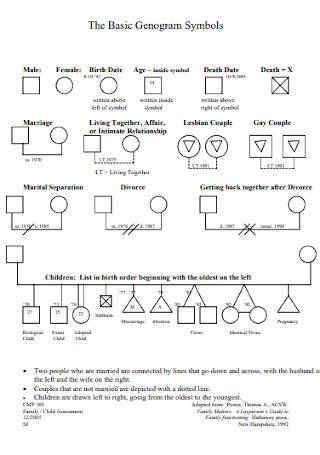
The genogram is a tool for systematically identifying who is in the family-getting around the common problem of some families not letting therapists know about key but conflicted or undesirable relations. One of the most important reasons for constructing a genogram is to obtain a more complete picture of the family constellation. The genogram is like a family tree in that it depicts all of the important relationships within the family. In our experience, “family” often includes all individuals living within a household (except for roommates and transient “live-ins”) as well as other important significant others who may or may not be biologically related to one another. What is required is a more flexible approach to identifying family/kin that examines: (i) blood relation and/or extended kinship (ii) perceived strength and duration of relation-ships and (iii) perceived support-in either direction-(including financial, emotional, and instrumental help, e.g., who provides transportation, child care, and other types of assistance). For example, in our own work with inner city African-American families (Greenwood, Herves et al., 1995 Greenwood, Samuels, et al., 1995), defining “family” solely through biological relationships fails to represent the complex family/kinship network of these families. The conventional genogram includes biological family however, genograms may also include individuals based on the function they serve within the family. The genogram is a frequently used method for identifying who is in the family, and what role important family members play with respect to one another. Jamie Miller, in Comprehensive Clinical Psychology, 1998 5.07.5.1.1 Family genogram Once completed, the therapist can, with the family’s permission, take a picture of the genogram, creating a permanent record of the final product. With support, even children as young as 5 years old can engage in this activity. Family members then select, from several miniature people, animals, and objects, an item to represent each person on the genogram, and take turns talking about their choices. The genogram is first drawn on a large sheet of poster board or paper and should include all biological and legal members of the family, as well as any other people important in the family and even pets. In this version, miniature toys are incorporated into the family creation of a genogram. This book includes a particularly useful chapter for play therapy treatment planning – Family Play Genograms, co-authored with Eliana Gil ( Gil, McGoldrick, Gerson & Petry, 2008). The genogram can be completed by hand and inserted into the ecosystemic intake, or it may be completed with one of several genogram computer programs now available, e.g., For additional information on creating genograms, see Genograms: Assessment and Intervention, 3rd edition ( McGoldrick, Gerson, & Petry, 2008). Intergenerational child abuse and/or substance abuse and/or mental illness should also be noted. If necessary, the genogram should be expanded to show how these individuals fit into the family tree. Īny hereditary or recurring illness, both medical and mental, should be noted.Again, this will give a more complete picture of the family and the nature of their relationships. It may be useful to include unrelated persons who live in the same household as part of the genogram. Often, families do not mention these members as they are not currently a part of the family.


This means you may have to ask directly about miscarriages, stillborn infants, and children who died in infancy. Īll family members, living and dead, should be included.Several items should be specifically noted on the genogram. The genogram should go back at least two generations and include all first-order relatives to provide as clear a picture of the family as possible.

A sample of the formats and symbols used to represent various familial relationships is included in the Intake form. The genogram gives the play therapist a visual representation of the family structure and history.


 0 kommentar(er)
0 kommentar(er)
